-
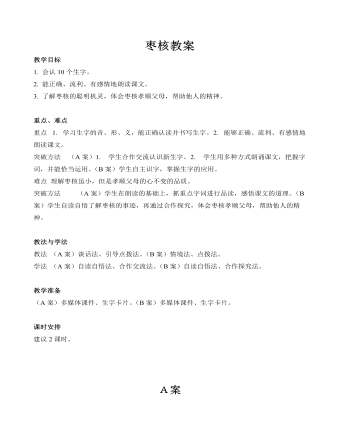
三年级下册《枣核》教案
精读课文,指导阅读1. 理解课文第1自然段。 (1)教师指名读,思考:这一个自然段讲了什么?(了解枣核出生的原因) (2)齐读第1自然段。2.理解第2~4自然段。 (1)理解:一年又一年,枣核一点儿也不见长,父母忧愁的原因。 (2)默读第2自然段,思考。(要给学生充分的时间读书、思考。为第3、4自然段的学习打下基础。) (3)自读第3~4自然段,回答问题。 ①枣核为什么让父母不用担心? ②枣核能做什么? ③大旱时发生了什么事? ④学生齐读。 ⑤提问:这一部分重点写了哪些方面?3.学习第5~13自然段。 (1)理解:大旱后,县衙门做了什么事?枣核又是怎么做的? (2)学生默读,思考。小组讨论、交流。 (3)全班交流,进一步深入理解。枣核的做法说明了什么?(联系上文,回答问题)而对枣核的决定,大家是怎样的态度?面对别人的不信任,枣核做出了怎样的选择?(板书:不争辩,靠行动说话)
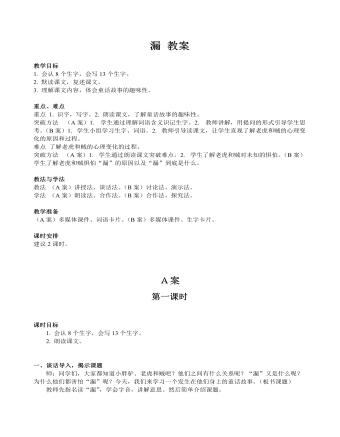
三年级下册《漏》教案
细读课文学生读课文,想想:“漏”指的是什么?学生自读、交流。1. 细读第1~5自然段。 (1)教师指名读,引导学生思考:这几个自然段主要告诉了我们什么? 师:“漏”指的是谁?老婆婆为什么说“什么都不怕,就怕漏”? (2)教师指导朗读。 教师指名试读,学生自由练读,最后集体齐读。2. 学习第6~18自然段。 (1)学生自由读课文,想想这些自然段讲了一个什么故事。 (2)教师指导朗读。学生自由练读,最后集体齐读。 (3)教师指名读选段,让学生说说老虎和贼之间发生了什么,为什么会出现这种情况。3. 学习第19~20自然段。 (1)教师指名读,要求学生思考:这两个自然段告诉了我们一件什么事? (2)天亮了,结果怎么样?(3)教师引导学生感受童话故事,体会其乐趣。
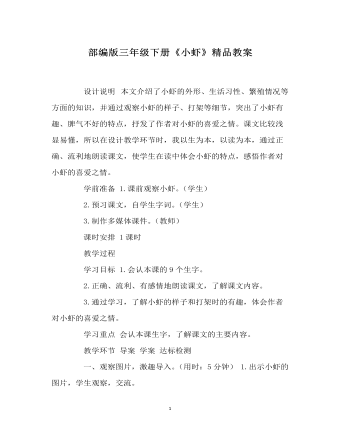
三年级下册《小虾》教案
◆观察细致,描述具体。(教学重点) 师:请同学们认真读一读第三自然段,思考:这一段是围绕哪句话来写的? 生1:这个自然段是围绕“缸里的小虾十分有趣”这一句来写的。 师:说得对。那么,作者是怎样描写小虾的有趣的? 生2:作者用“有的……有的……有的……”这样一个排比句写出了小虾在缸里不同的状态。 生3:作者观察了活动的小虾和休息的小虾不同的表现。 师:说得很好。那休息的小虾和活动的小虾有怎样的表现呢? 生1:休息的小虾受到打扰时会很生气。作者观察很细致,用“一张一张、一翘一翘、一突一突”这些词语写出了小虾生气时的表现,很有趣。
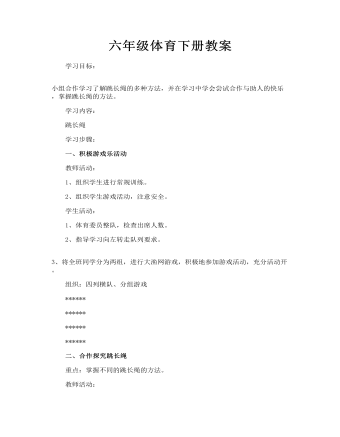
六年级体育下册教案
一、积极游戏乐活动 教师活动: 1、组织学生进行常规训练。 2、组织学生游戏活动,注意安全。 学生活动: 1、体育委员整队,检查出席人数。 2、指导学习向左转走队列要求。
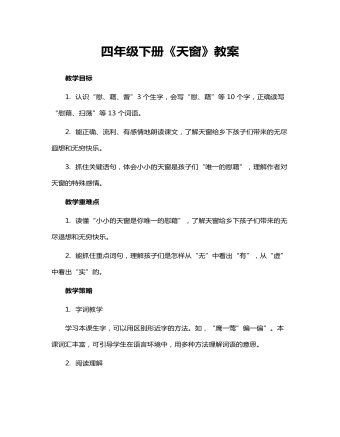
四年级下册《天窗》教案
教学目标1. 认识“慰、藉、瞥”3个生字,会写“慰、藉”等10个字,正确读写“慰藉、扫荡”等13个词语。2. 能正确、流利、有感情地朗读课文,了解天窗给乡下孩子们带来的无尽遐想和无穷快乐。3. 抓住关键语句,体会小小的天窗是孩子们“唯一的慰藉”,理解作者对天窗的特殊感情。教学重难点1. 读懂“小小的天窗是你唯一的慰藉”,了解天窗给乡下孩子们带来的无尽退想和无穷快乐。2. 能抓住重点词句,理解孩子们是怎样从“无”中看出“有”,从“虚”中看出“实”的。教学策略1. 字词教学学习本课生字,可以用区别形近字的方法。如,“鹰一莺”编一偏”。本课词汇丰富,可引导学生在语言环境中,用多种方法理解词语的意思。2. 阅读理解主要采用提出问题引导阅读的方式教学:先让学生带着疑问读课文,接着细读课文并思考天窗给乡下的孩子带来了什么,然后抓住文章的中心句“小小的天窗是你唯一的慰藉”一句理解课文,最后结合全文内容体会孩子被唤回家时的失落,又从天窗中想象出无穷的情形、故事,找回了失去的快乐。3. 表达运用运用读写结合的策略,学习课文后,启发学生结合自己的生活实际谈感受,写感受。教学准备1. 预习提纲:完成《状元大课堂·好学案》对应课文预习作业。2. 准备资料:多媒体课件。教学课时:2课时第1课时,课时目标:1. 认识“慰、藉、瞥”3个生字,会写“慰、藉”等10个字,正确读写“慰藉、扫荡”等13个词语。2. 能正确、流利地朗读课文,整体感知课文主要内容,理清课文脉络。教学过程板块一,设疑激趣,导入新课。1. 导入新课。(1) 课件出示天窗图片。(2) 师引导:同学们,你们知道这是什么吗?(3) 了解课文题目。师板书课题:天窗;指名读课题。(4) 设置疑问。师引导:看到课题,同学们有什么想问的吗?(示例:什么是天窗?)
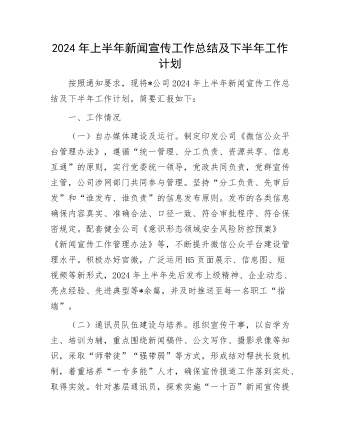
2024年上半年新闻宣传工作总结及下半年工作计划
3.视频优先,融入企业安全生产及感恩教育。针对职工群众阅读习惯更加碎片化和场景化的特点,把短视频作为自办媒体的重点,并将其融入企业安全教育工作。譬如,持续开展“亲情嘱安全”视频征集活动,吸引广大干部职工家属积极参与,选拔优秀视频进行表彰奖励,并利用工广、井口、区队电视屏滚动播放,使安全主题与职工家属心声,同频共振、入脑入心,筑牢安全第一道防线,集聚企业发展磅礴力量。4.加大考核,提升基层全员写稿撰稿积极性。明确专人负责摄像、信息和新闻稿件撰写、图片编辑、外宣以及与各级媒体联系衔接等工作,进一步健全完善新闻宣传奖惩制度,明确经验文章、研讨论文、通讯等各类文章在各级刊物媒体发表的奖励标准,月度统计、季度奖惩、年底表彰,充分调动全员撰写稿件的积极性。
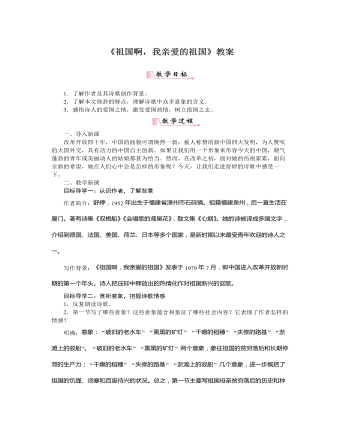
部编版语文九年级下册《祖国啊,我亲爱的祖国》教案
4.联系作者的写作背景赏析第三节,说说第三节中的意象有怎样的象征意义。通过这些意象,我们可以看出作者的思想感情有怎样的变化?明确:意象:“神话的蛛网”“雪被下古莲的胚芽”“挂着眼泪的笑涡”“雪白的起跑线”“绯红的黎明”。“神话的蛛网”象征束缚生产力发展,钳制思想解放的专制统治和陈腐意识,只有挣脱了“神话的蛛网”才能诞生“簇新的理想”;“雪被下古莲的胚芽”“挂着眼泪的笑涡”“雪白的起跑线”“绯红的黎明”这些意象在时空上大幅度跳跃,构成了立体交叉象征义,象征着祖国成长的苦难历程、再生的悲喜、新长征的开始和未来的美景。上述意象有一个共同的特征,那就是代表着希望,代表着开始。作者正是用这些意象,表现着自己的欣喜与激动。
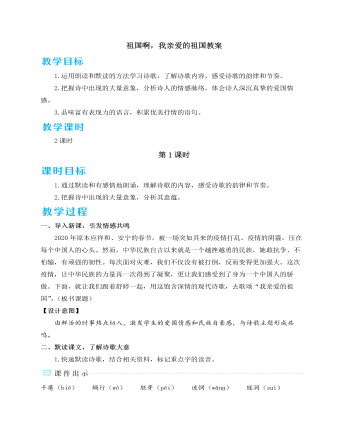
人教部编版语文九年级下册祖国啊,我亲爱的祖国教案
诗歌创作个性十足,难以用统一的规律去分析,然而发掘一些欣赏诗歌的一般性的思路和角度,可以让阅读诗歌有章可循,减少学生读诗时的畏难情绪。在第1课时中,我以朗读为贯穿课堂的抓手,让学生通过思考“怎么读”,自觉地去发现并分析诗歌中的意象,理解诗歌大意,让学生对诗歌有初步的理解和体会。第2课时在整体把握诗歌的基础上,具体去分析诗歌中富有表现力的语言,训练学生深入思考的能力,引导学生梳理诗歌的情感脉络,体会诗中作者的情感变化,理解诗人想要表达的真挚情感,并通过拓展阅读让学生尝试自己解读诗歌,帮助学生巩固所学的阅读诗歌的方法。两节课的侧重点不同,但都围绕这首诗的特点和整体教学思路进行规划,做到“一课一得”。写作背景舒婷初中毕业后下乡插队,后又当过工人。在国家蒙难、人民遭殃的非常岁月,备尝艰辛的舒婷,内心的迷惘、痛苦可想而知。1978年12月,中国迎来了具有重大历史意义的十一届三中全会,开启了改革开放的历史新时期。1979年4月,诗人面对祖国摆脱苦难、正欲奋飞的情景,以自己独有的抒情方式写下了此诗。

2024年度某国企上半年工作总结及下半年工作计划
下半年年,我公司将坚持“xx”的原则,按照改革既定时间表、任务书,重点抓好以下几个方面的工作:(一)聚焦深化改革,坚持解放思想,夯实高质量发展思想基础xx改革已经落实落地,但我们作为企业运营才刚刚起步。广大干部职工在思维上还没有从xx转变为xx,思想上还没有完全适应现代企业。要进一步解放思想、打开思路、对标看齐,不断巩固“xx”专项活动成果,围绕高质量发展要求,贯彻落实新发展理念,进一步战略性布局、前瞻性思考产业经济发展,教育引导广大干部职工牢固树立严谨认真的处事态度、求真务实的工作作风。努力实现在思想上破冰、在行动上突围、在改革上发力、在发展上突破,真正以思想大解放推动改革再深入、实践再创新。(二)聚焦提质增效,深化规范运行,健全高质量发展制度体系

2024年国企集团公司上半年工作总结和下半年计划业务汇报
二是聚焦能力建设,掌握新技术,打造竞争力。当前检测企业间竞争日趋激烈,国际事业部人才流失较为明显,推动发展的“驱动力”呈现弱势。我们将围绕国际化人才梯队建设,出台配套支持政策,提升队伍能力,快速掌握Wi-Fi7、5G毫米波等前沿无线技术,提升本地化测试能力,解决客户产品全生命周期中面临的新技术导入滞后、认证标准理解偏差等问题,助力企业打造具有国际竞争力的产品。三是聚焦业务推厂,瞄准大趋势,实现大突破。面对国际认证市场日益萎缩的现状,我们将把视线放到发展“潜力”上来,更加重视“一带一路”国家和第三世界国家的需要,立足检测中心的技术、服务优势,依托我国“一带一路”整体思路,针对发展中国家检测能力弱、发展需求大等特点,以产业升级、技术出口,找到国际业务发展“突破点”“新蓝海”。
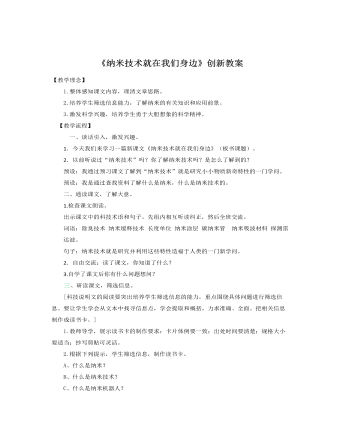
部编人教版四年级下册《 纳米技术就在我们身边》创新教案
【教学理念】 1.整体感知课文内容,理清文章思路。2.培养学生筛选信息能力,了解纳米的有关知识和应用前景。3.激发科学兴趣,培养学生勇于大胆想象的科学精神。【教学流程】一、谈话引入,激发兴趣。1.今天我们来学习一篇新课文《纳米技术就在我们身边》(板书课题)。2.以前听说过“纳米技术”吗?你了解纳米技术吗?是怎么了解到的?预设:我通过预习课文了解到“纳米技术”就是研究小小物质新奇特性的一门学问。预设:我是通过查找资料了解什么是纳米,什么是纳米技术的。二、通读课文,了解大意。1.检查课文朗读。出示课文中的科技术语和句子。先组内相互听读纠正,然后全班交流。词语:除臭技术 纳米缓释技术 长度单位 纳米涂层 碳纳米管 纳米吸波材料 探测雷达波。句子:纳米技术就是研究并利用这些特性造福于人类的一门新学问。2.自由交流:读了课文,你知道了什么?

人教版新目标初中英语七年级下册How was your weekend教案2篇
Teaching Goal:1. General aims:Talk about recent past events2. Particular aims:A. Language Focus.Talk about recent past events and think of the past events.B. Language goalsHow was….?It was …What did …do over the weekend?C. Language structures:(1). How was your weekend? I was great. Pay attention to no form.(2). What did you do over the weekend? I played soccer. We went to the beach.D. Useful words and phrases:Words: was, did, went, beach, over, project, test, wasn’t, false, number, geography, spend, week, most, mixture, their, had, little, cook, read, saw, change, everyone, sit, sat, no, anythingPhrases: did one’s homework, played soccer, cleaned my room, went to the beach, played tennis, went to the movies, on Saturday morning, over the weekend, cook … for, what about, do some reading, have a party, talk show, go shoppingE. Grammar language:Present simple past tenseRegular and irregular verbsF. Learning strategies:Tour and holidaysG. Interdiscipinary:H. Emotion and manner:Teaching time: 5 periodsTeaching procedures:Period One教学步骤、时间 教师活动 学生活动 媒体应用Step 1Free talk 3’ Ask some questions like:Who’s on duty today?What’s the weather like? Answer and talk about something.让同学们回答下列问题1. Do you like weekend? (Let some students answer)It takes them three minutes to talk about the question.2. Why do you like weekend? (let the students answer) Most of the students like the weekend此时教师用汉语问:“在周末期间问你干了什么?这句话用英语这么回答?Let the students guess.At last the teacher give them right answer3. What did you do over the weekend?(板书、学习)

人教版新目标初中英语七年级下册What does he look like教案3篇
所需要用到的句子:Who is that?That is Jack. I like him.Why do you like him?I like him because he is interesting.Task 4: 设计理想中的人类Step one: 设计理想中的人类的外貌。把全班同学分成若干小组,学生可以边说边在纸上画出他们的模样。Step two: 设计理想中人类的性格。学生们可以把那些能描述性格的单词写在图画的旁边。Step three: 每组选出一名同学,其他同组同学提问,他作简单回答,并说明原因。所需用到的句子:What does he or she look like?He or she ...What is he or she like?He or she is ...Why?Because ...Task 5: 挑战性活动调查性格是天生的还是后天形成的,让每个同学回家去调查一下自己成长过程中性格是否有变化,具体是怎样的,为什么会这样? Teaching Aims:1. Enable students to have a general understanding of how to talk about people's physical appearance.2. Enable students to tackle some essential vocabularies and patterns about describing people. Provide them with necessary skills and methods.3. Create various chances for students to describe the persons they're familiar with, such as classmates, family members, teachers, idols, etc.

人教版新目标初中英语七年级下册Where is the post office教案2篇
Period 2 (3a----Section B 2c)Preview(Pre-task): Key points: What laAdd another information about their pen pals----their language on the cardnguage does she/he speak?She/He speaks....Does she/he have any brothers and sisters? Does she/he speak English?Preview(Pre-task): Add another information about their pen pals----their language on the cardKey points: What language does she/he speak?She/He speaks....Does she/he have any brothers and sisters? Does she/he speak English?Step 1 Revision1.Revisionand dictation of the new words 2.Revise the drills they learned yesterday.(by pairwork and grammar exercise)Step 2 Leading-inT has a conversation with one student. The conversation is following:---Do you have a pen pal?---Yes, I do.---What's your pen pal's name? ---His/Her name is....---Where is your pen pal from? ---He/She is from...---Where does he/she live? ---He/She lives in....---What language does he/she speak?He/She speaks...Write the new words on the Bb. They are following: EnglishChineseJapaneseFrenchStep 3 LearnLearn the new words with the whole class.Finish 3a with the students3b Pairwork T still does an example with one student Then the Ss practise in pairs. The example is following:--Curry Muray is my pen pal. He is from the United States.---What language does he speak?

人教版新目标初中英语七年级下册Don’t eat in class教案2篇
Don’t fight. =You can’t fight. (板书,教读)教师把这些句子板书在黑板上,并请学生大声整齐地读祈使句和“can’t”句型,并让学生注意两种句型表达形式的不同和转换,“Don’t …=You can’t…”;并对学生说:These are our school rules. (板书,教读) You can’t break the school rules. Don’t break the school rules.(板书,教读)步骤3 :Practicea. T: Now, each of the students is breaking one of these rules.Please finish 1a.学生看图,完成1a的内容,检查答案并大声朗读校规。b. 听录音,完成1b,选出四位学生都违反了哪条校规;听之前,学生要读会英文名。c. 请两位学生朗读1c部分的句型;要求学生两人一组对话表演,SA扮演外校转来新生,SB告知本校校规。(学生可经过讨论,多说出他们想到的校规,不必只限于书上;教师应给予帮助)2) 第二课时(2a~4)步骤1 :warming up of revisionT: What are the rules at your school?学生使用“can”或祈使句表达各条校规;其中老师可引出“eat in the cafeteria outside”的表达。步骤2 :Practicea.T: Christina is an exchange student. She doesn’t know the rules. Let’s listen, what activities they’re talking about?学生听第一遍时,完成2a;第二遍时,完成2b;b. 请学生领读2c部分,看着2a完成的表格,理解2c活动的要求;分成小组针对2a进行问答;

人教版新目标初中英语七年级下册I ’d like some noodles教案
教学过程Step 1: warming-up Sing a song---------“food and drink” Step 2: Revision1 Dictation2 Revise: What kind of noodles would you like?I’d like …What size bowl of noodles would you like?I’d like…Step 3: Presentation1 show pictures of food, ask students say the words.2 Students read the newspaper ad in 3a. Fill in blanks with words in the box. Then read the ad together, the teacher explains some difficult language points.3 Check the answers Step 4 PracticeAsk students to finish 3b in the same way according to 3a. Students read the short passage and fill in the blanks .At last, check the answers.Step 5 productionAsk students to write their own ad for dumplings, noodles, drinks, and other foods they know. Then ask students to read their partner’s ad. Then order food and drink from their partner.Step 6 Home workGroup work – make an ad about “food and drink”

人教版新目标初中英语七年级下册I want to be an actor教案2篇
三、教学建议第一课时:1. Lead in (Vocabulary)A) Before class, teacher should collect some pictures of working places. For example: Bank, TV Station, Restaurant, Police Station, Hospital ...B) In class, show students the pictures (PowerPoint, OHP). Ask students to tell the name of the working places and the name of the jobs.Shop assistant, doctor, actor, reporter, police office, waiter, bank clerk, studentC) Do exercise 1a and 3a.2. Bingo GameAsk groups of students to make up pairs of cards with a job on one and the related workplace on the other. For example, waiter / restaurant, teacher / school, doctor / hospital. Encourage students to use both the job / workplace combinations in the book and the ones that students came up during class discussions. Be sure they have twice as many sets of cards as there are students in the group. They can make two sets of cards for a single job / workplace, if necessary. Then have each group mix up its set of cards and hand their cards out in random order. Each time a student gets a pair of cards that match, he or she can lay these cards down. The goal is to have no cards in your hand at the end.3. Task OneA) Ask students to work in pairs and ask the partner what does he / she want to be in the future.e. g. :What do you / does he / does she want to be?I want to be a.Why?Because it's (adj).B) Vocabulary: Section B, 1a4. Homework 1.2.

人教版新目标初中英语七年级下册It’s raining教案2篇
1 Each group choose one place to describe and what you are doing in it Choose one place, and describe what they are doing 2 Move around the room and give suggestions Talk about it and write it down 3 Ask one to show their works and act it Choose one of each group to make a report 4 Evaluate the best group and the best reporter Choose the best one Homework Ask your friends their ideal place and write about it教学反思:新课程标准中强调学生在课堂中的主体地位,在综合课中他们的主体地位就更加突出。在各个活动中给不同程度的学生不同层次的任务,让各层面的学生都有表现发挥的机会,从而产生对英语的兴趣。使用照片图片多媒体来辅助教学,效果更好。同时让了解其他国家风景,风俗的同学介绍ideal place,增加学生的背景知知识,实现跨学科交流的目的。教案点评:采用任务型教学模式,在各个活动中给不同程度的学生不同层次的任务,让各层面的学生都有表现发挥的机会,从而产生对英语的兴趣。使用照片图片多媒体来辅助教学,效果更好。让了解其他国家风景,风俗的同学介绍ideal place,增加学生的背景知识,实现跨学科交流的目的。

人教版新目标初中英语七年级下册Where is your pen pal from教案
2.1Match the country with the language.Step II Reading3a? let the students read the letter fast and answer the questions.? Let the students ask more questions about the letter as possible as the can.Step III Writing3b.Step IV. Pairwork2cStep V Listening2a, 2bStep V. HomeworkExercises book(1) P3Exercises book (2) P3Period FourStep I . Dictate the words and sentences in Unit1.Step II. Self-checkStep III. Check the answers for Exercises book in the unit.Step IV. Home workRevise and preparation for unit 2.教学反思:通过本单元的学习,学生基本可以谈论人们的国籍,居住城市及其所说的语言,通过书信方式去介绍自己并寻找笔友。但在涉及到国外的一些城市时,学生对这方面的知识相对欠缺,能介绍的城市并不多,也反应出学生课前预习不充分,这跟学生学习条件也有关,大多数学生无法通过网络获取所需信息。因此,在以后的教学中要多指导学生通过计算机网络获取信息,拓宽知识面。

人教版新目标初中英语七年级下册What do you think of game shows教案
五、教学Section B-2c1. Pair work: What do you think of the belt/sunglasses/…? What does your father/mother/… think of your scarf/belt…?2. Group work(1). Teacher shows some different kinds of school uniforms (制服)and asks : “ What do you think of your school uniforms? If you have a chance to choose your school uniforms, what kind would you like to choose?”(2). Discuss in groups.(3).Get some Ss to report in class.说明:这一步旨在让学生运用已有的语言知识谈论对事物的看法和意见,并简单阐明理由,培养学生的主动思维能力和运用英语的能力。六、教学拓展调查电视节目的收视率任务:调查你周围的人对现在各种电视节目的反响。活动过程:1.教师布置任务,让学生调查周围的人(包括他的亲戚朋友和邻居)喜欢收看哪方面的电视节目。2.学生进行调查活动,运用本单元所学的句型What do you think of….? (Why?)What's your favorite game shows?What do you think of talk show?I doesn’t mind it.I like it.I love it.I can’t stand it.3.记录下排在前10位的TV Program,填写调查表,比较其收视率。





